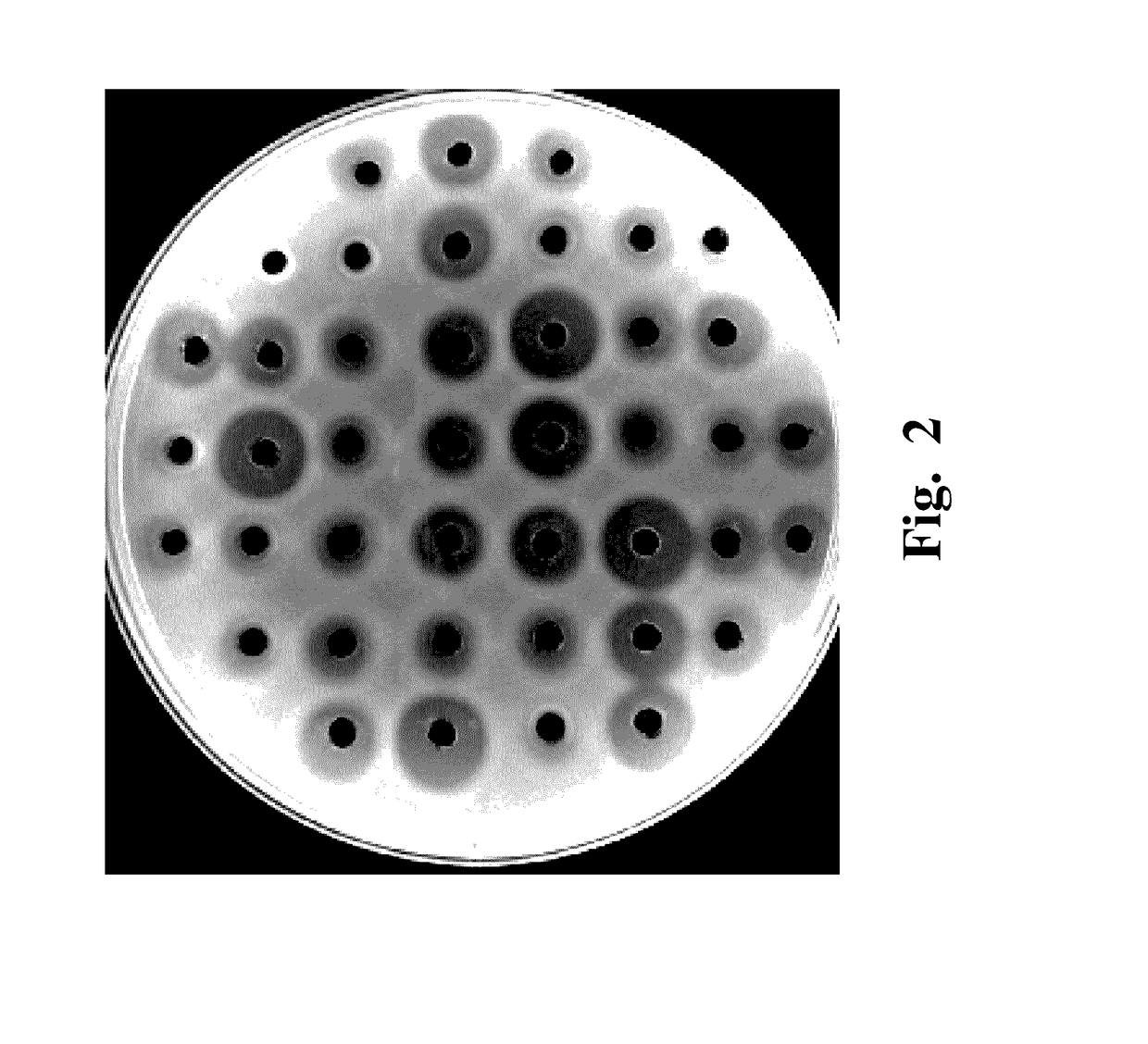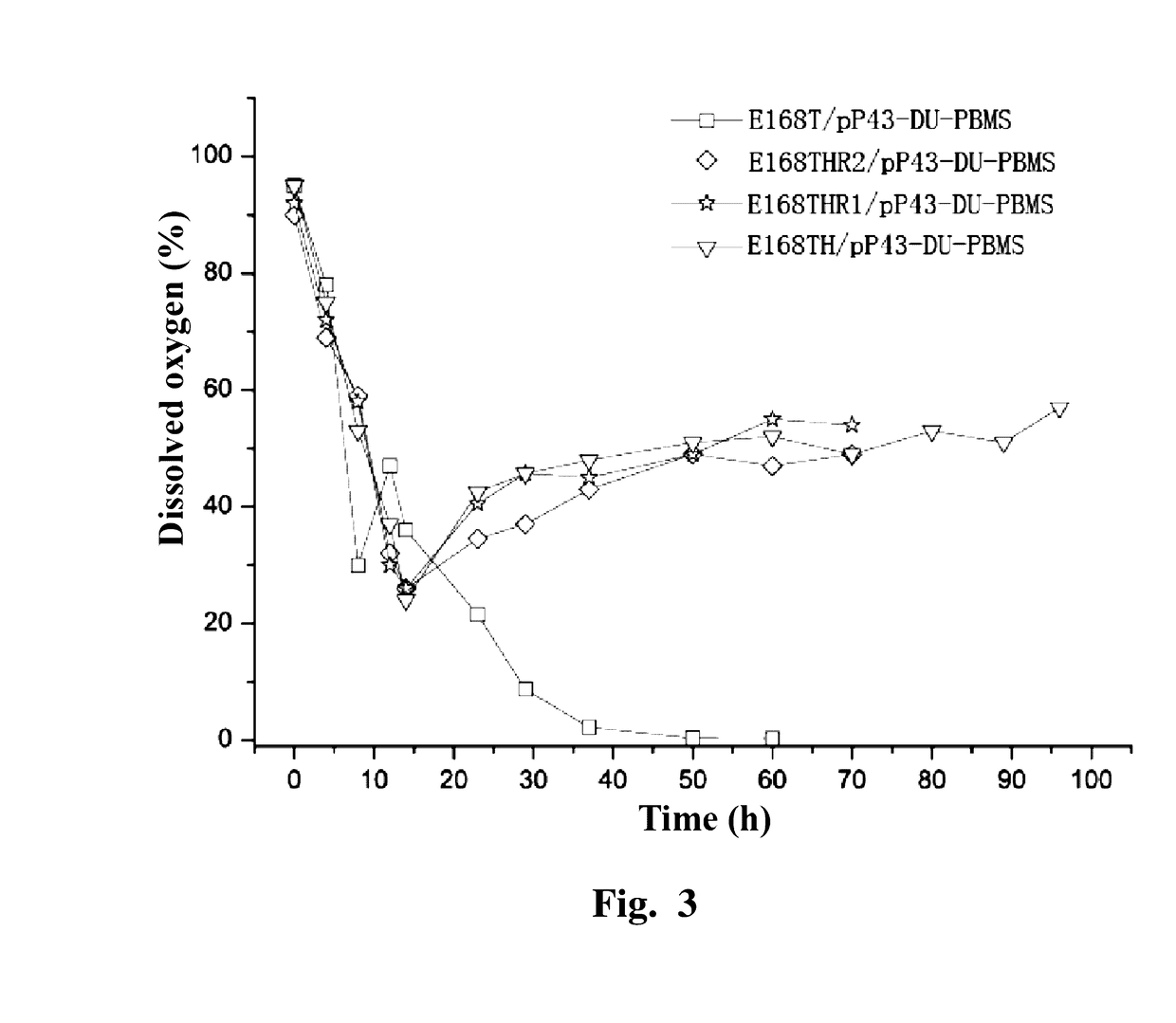Method of constructing a recombinant Bacillus subtilis that can produce specific-molecular-weight hyaluronic acids
a bacillus subtilis and specific-molecular-weight technology, applied in the field of biotechnology engineering, can solve the problems of poor product stability, high purification cost, and difficulty in large-scale production
- Summary
- Abstract
- Description
- Claims
- Application Information
AI Technical Summary
Benefits of technology
Problems solved by technology
Method used
Image
Examples
example 1
Construction of the Recombinant Plasmid pAX01-hasA
[0059]Hyaluronan synthase hasA was cloned from S. zooepidemicus ATCC 35246 with primers hasA-F / hasA-R to amplify the hasA gene by polymerase chain reaction (PCR). The S. zooepidemicus strain was incubated in 5 mL M17 media at 37° C., 200 rpm for 16 hours, and the chromosome of S. zooepidemicus was extracted by a bacterial genome extraction kit.
[0060]The nucleotide sequences of primers hasA-F and hasA-R were as follows (from 5′ to 3′):
hasA-F:(SEQ ID NO: 15)CGCGGATCCATGAGAACATTAAAAAACCTCATAAChasA-R:(SEQ ID NO: 16)TGCATGCATTTATAATAATTTTTTACGTGTTCC
[0061]Gene fragment of hasA amplified by PCR and pAX01 plasmid were digested with restriction enzymes BamHI and SacII, respectively. The digested fragments were recovered for ligation. Then the ligation products were used to transform to JM109 competent cells and positive recombinant plasmid pAX01-hasA was verified by sequencing. Then, the pAX01-hasA was transformed into B. subtilis 168, result...
example 2
Construction of the Recombinant Plasmid pP43NMK / pP43-DU-PBMS
[0062]tuaD gene and glmU gene were amplified from B. subtilis 168 by PCR using primers tuaD-F / tuaD-R and glmU-F / glmU-R, respectively. KpnI restriction site and P43 RBS sequence (shown in SEQ ID NO:14) were introduced to the 5′ of tuaD-F. SacI restriction site was introduced to the 5′ of tuaD-R. SacI restriction site and P43 RBS sequence were introduced to the 5′ of glmU-F. XhoI and XbaI restriction sites were introduced to the 5′ of glmU-R. The resulting tuaD fragment and glmU fragment were digested with KpnI / SacI and SacI / XhoI, respectively. The digested fragments were purified and ligated together with digested pP43NMK (KpnI / XhoI) fragment. Then, the obtained ligation product was transformed into JM109 competent cells. The positive recombinant cells was verified by sequencing and the recombinant plasmid was designated as pP43-DU.
[0063]The Pveg promoter fragment amplified with the primer pair Pveg-F / Pveg-R was fused with t...
example 3
Construction of the Integrated Gene Fragment of LHyal
[0066]The gene encoding hyaluronidase was integrated at the glucosamine-6-phosphate deaminase 1 (nagA-nagBA) locus of B. subtilis 168 using Zeocin gene as the selection marker. The integrated fragment (shown in FIG. 1) was obtained by homologous recombination technique.
[0067]The primers used were as follows:
H6LHyal-F:(SEQ ID NO: 28)ATGCACAGTCTGCAGAATTCCACCACCACCACCACCACATGH6LHyal-R:(SEQ ID NO: 29)TTACTTTTTGCACGCTTCAACATZHLHPlepA-F:(SEQ ID NO: 30)CGCAGCCAAAGGAGTGGATTGCCTCAATCCTAGGAGAAACAGZHLHPlepA-R:(SEQ ID NO: 31)GAATTCTGCAGACTGTGCATGAGCZHLH-front-F:(SEQ ID NO: 32)TCAGCTGGTCTAGATCACTAGTCZHLH-front-R:(SEQ ID NO: 33)AATCCACTCCTTTGGCTGCGCTCZHLH-zeocin-F:(SEQ ID NO: 34)TTGAAGCGTGCAAAAAGTAAGAGCTCGGTACCCGGGGATCCZHLH-zeocin-R:(SEQ ID NO: 35)GCTTGCATGCCTGCAGGTCGACZHLH-back-F:(SEQ ID NO: 36)CGACCTGCAGGCATGCAAGCCACTTCTTTCAGACGGAACCCTTGCZHLH-back-R:(SEQ ID NO: 37)CGGTCGTTCATATAGAAGTGATAGZHLH-pSK-F:(SEQ ID NO: 38)CACTTCTATATGAACGACCGCCTGTGTGA...
PUM
| Property | Measurement | Unit |
|---|---|---|
| molecular weight | aaaaa | aaaaa |
| molecular weight | aaaaa | aaaaa |
| molecular weight | aaaaa | aaaaa |
Abstract
Description
Claims
Application Information
 Login to View More
Login to View More - R&D
- Intellectual Property
- Life Sciences
- Materials
- Tech Scout
- Unparalleled Data Quality
- Higher Quality Content
- 60% Fewer Hallucinations
Browse by: Latest US Patents, China's latest patents, Technical Efficacy Thesaurus, Application Domain, Technology Topic, Popular Technical Reports.
© 2025 PatSnap. All rights reserved.Legal|Privacy policy|Modern Slavery Act Transparency Statement|Sitemap|About US| Contact US: help@patsnap.com



